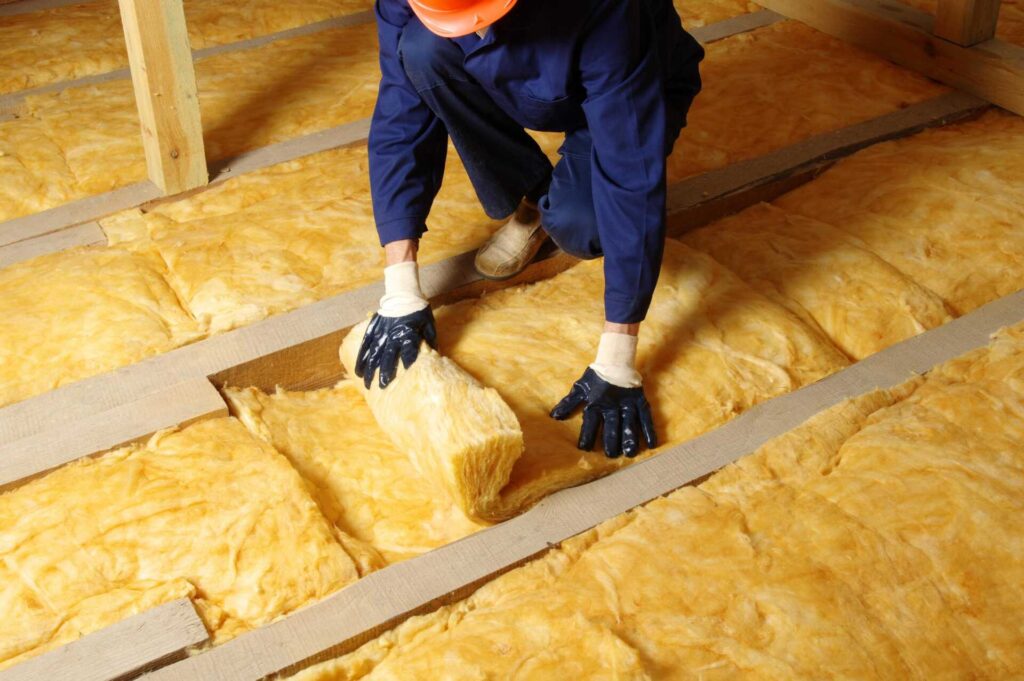
Contents
When you think about upgrading your older home’s attic insulation, you might wonder what options are available and how they can improve your living space. By considering materials like fiberglass, you can tackle issues like heat loss and moisture buildup effectively. But it’s not just about comfort; these upgrades can also lead to significant savings on your utility bills. As you explore the potential benefits further, you might find that the right insulation choices can truly transform your home’s energy efficiency and overall value. What might those choices look like for you?
Key Takeaways
- Upgrading to fiberglass insulation enhances thermal performance, reducing energy costs and improving comfort in older homes.
- Proper air sealing around common leakage areas prevents drafts and moisture intrusion and enhances insulation effectiveness.
- Removing old insulation allows for the identification and remediation of mold or pest issues before installing new insulation.
- Installing blow-in insulation effectively fills gaps in hard-to-reach areas, optimizing energy efficiency and maintaining consistent indoor temperatures.
- Energy-efficient upgrades can increase home value and marketability, appealing to potential buyers seeking lower utility bills and enhanced comfort.
Importance of Attic Insulation
While many homeowners overlook the attic when considering energy efficiency, proper insulation in this space is crucial for maintaining a comfortable living environment. Insulation acts as a barrier, regulating the attic temperature, preventing heat from escaping during winter, and keeping unwanted heat out during summer. This balance is essential not only for comfort but also for your energy bills.
If your attic isn’t well-insulated, you might be wasting significant energy trying to maintain a steady temperature throughout your home. Heated or cooled air can easily escape, forcing your HVAC system to work harder, which ultimately leads to higher energy costs. With effective insulation, you can improve your home’s energy efficiency, making it more comfortable while saving money in the long run.
Moreover, proper attic insulation also plays a vital role in preventing moisture buildup, which can lead to mold and structural issues. By maintaining an optimal attic temperature, you’re not just protecting your energy bills; you’re safeguarding your home’s integrity.
When you prioritize attic insulation, you join a community of homeowners who understand the importance of energy efficiency. This investment enhances your living space and contributes positively to the environment by reducing energy consumption.
You’re not just insulating an attic; you’re taking a step toward a more sustainable lifestyle. Remember, a well-insulated attic is the backbone of a comfortable, energy-efficient home.
Types of Insulation Materials
When it comes to upgrading your attic insulation, understanding the various materials available is crucial.
Fiberglass insulation offers excellent thermal performance and is easy to install.
Cellulose, made from recycled paper, is an effective and eco-friendly choice that enhances energy efficiency.
Fiberglass Insulation Advantages
If you’re considering insulation upgrades for your older home’s attic, fiberglass insulation stands out due to its numerous advantages. One of the key fiberglass properties is its excellent thermal resistance, which helps maintain a consistent indoor temperature. This enhances your comfort and reduces energy bills, making your home more energy-efficient.
Another significant benefit is the insulation lifespan. Fiberglass insulation can last for decades without losing its effectiveness, allowing you to invest in a long-term solution for your attic. It’s also non-combustible, providing an added layer of safety for your home.
Here are some other advantages of fiberglass insulation:
Cost-effective: It’s generally less expensive compared to other insulation materials.
Moisture resistant: It doesn’t absorb water, which helps prevent mold growth and structural damage.
Easy installation: Fiberglass rolls or batts can be installed by most DIY enthusiasts, making them accessible for homeowners.
Cellulose Material Effectiveness
Cellulose insulation, made from recycled paper products, stands out as an eco-friendly option for insulating older home attics. When you consider upgrading your insulation, cellulose offers impressive benefits that enhance energy efficiency and comfort.
Here are some key cellulose benefits:
Sustainability: Since it’s crafted from recycled materials, using cellulose supports environmental conservation.
Effective Air Barrier: Cellulose installation creates a dense, snug fit, minimizing air leaks and keeping your home cozy.
Sound Absorption: This material excels at dampening noise, providing a quieter living environment.
One of the major advantages of cellulose is its ability to resist pests and mold, thanks to treatments applied during production.
Plus, its excellent thermal performance can significantly lower your heating and cooling bills, making it a practical choice for homeowners looking to save money long-term.
If you’re aiming for a sustainable, efficient, and comfortable attic, cellulose insulation could be the perfect solution.
Benefits of Blow-In Insulation
Blow-in insulation offers a range of advantages for homeowners looking to upgrade their attic’s energy efficiency. One of the key benefits is its ease of installation. Unlike traditional batts or rolls, blow-in installation involves simply blowing the insulation material into the attic space, allowing for quick coverage even in hard-to-reach areas. This method saves you time and minimizes disruption to your home.
Another significant advantage is the versatility of insulation density. Blow-in insulation can be tailored to meet specific R-value requirements, ensuring optimal thermal performance. You can choose a denser product for areas that experience extreme temperatures or a lighter option for moderate climates. This adaptability makes it an excellent choice for older homes that may have unique insulation needs.
Additionally, blow-in insulation is often made from recycled materials, such as cellulose, which can make it an environmentally friendly option. By choosing this type of insulation, you’re improving your home’s energy efficiency and contributing to a more sustainable future.
Moreover, blow-in insulation effectively fills gaps and voids, preventing air leaks that lead to energy loss. This thorough coverage enhances your home’s comfort levels, making it easier to maintain a stable indoor temperature year-round.
Air Sealing Techniques
Air sealing is crucial for maintaining energy efficiency in your older home attic.
You’ll want to identify common leakage areas, such as around ducts, vents, and electrical fixtures, to ensure a tight seal.
Importance of Air Sealing
One of the most crucial steps in enhancing your older home’s energy efficiency is effective air sealing. This process ensures that unwanted airflow is minimized, which can lead to significant energy savings and improved comfort.
By sealing gaps and cracks in your attic, you’ll prevent conditioned air from escaping and reduce moisture infiltration. Proper moisture control is vital in preventing mold growth and maintaining the integrity of your home.
Here are a few key benefits of air sealing:
- Improved Energy Efficiency: Reduced air leaks lead to lower energy bills and a more comfortable indoor environment.
- Enhanced Indoor Air Quality: By limiting outside air infiltration, you can reduce dust and allergens in your home.
- Extended Roof Lifespan: Effective sealing helps prevent moisture-related damage, prolonging the life of your roof and attic structure.
Incorporating air sealing techniques is an essential part of your insulation upgrade strategy.
Common Leakage Areas
After you’ve taken steps to seal the air leaks, it’s important to identify the common leakage areas in your attic where energy loss often occurs. One of the primary culprits is around attic vents. These openings are necessary for ventilation, but they can also allow warm air to escape in winter and enter in summer if not properly sealed.
Check for gaps and ensure that they’re adequately insulated.
Another area to inspect is around your drafty windows. Air can seep in through poorly sealed frames, causing discomfort and increasing energy costs. You might consider adding weatherstripping or caulking to create a better seal and minimize drafts.
Don’t forget about the spaces around plumbing and electrical penetrations, as these can also be significant sources of air leakage.
By addressing these common leakage areas, you can enhance your home’s energy efficiency and comfort. Taking the time to seal these leaks improves your attic insulation’s effectiveness and creates a more welcoming environment throughout your home.
Sealing Materials and Techniques
When it comes to effectively sealing your attic, choosing the right materials and techniques is crucial for maximizing energy efficiency. Proper air sealing helps prevent drafts and moisture from compromising your insulation barriers, which can lead to increased energy bills and discomfort in your home.
You’ll find several sealant options available, but it’s essential to select the ones that best suit your specific needs. Here are some techniques to consider:
Caulk: Use high-quality caulk around gaps and cracks, especially around windows, ducts, and plumbing penetrations.
Weatherstripping: Install weatherstripping on movable components like attic hatches and doors to minimize air leakage.
Foam Sealants: For larger gaps, expanding foam sealants can fill voids effectively, creating a tight seal.
Incorporating these techniques can significantly enhance your attic’s performance.
Remember, sealing is just as vital as insulation; if your barriers aren’t intact, you’ll lose the benefits of your insulation upgrades.
Upgrading Existing Insulation
Upgrading existing insulation in your attic is a crucial step toward enhancing your home’s energy efficiency and comfort. Many older homes have outdated insulation that may have deteriorated over time, affecting its thermal performance.
Before you can effectively upgrade, you’ll need to consider insulation removal. This process involves carefully taking out old, damaged insulation to make way for new material that meets modern standards.
When you remove existing insulation, you not only eliminate potential mold or pest issues but also create an opportunity to assess your attic’s overall insulation needs. It’s essential to choose the right type of insulation that suits your climate and home design. Options like fiberglass batts or cellulose can significantly improve your attic’s thermal performance when installed correctly.
You’ll want to ensure that the new insulation is appropriately layered and meets the recommended R-value for your region. This value indicates the insulation’s effectiveness in resisting heat flow—higher R-values mean better insulation.
By upgrading your attic insulation, you’re not just making a wise investment in your home’s efficiency, but you’re also enhancing your living environment.
Moreover, a well-insulated attic can lead to more stable indoor temperatures year-round, contributing to a cozy, comfortable home where you and your family can thrive.
Embrace this opportunity to improve your home’s performance and join a community of homeowners committed to sustainable living.
Energy Savings Potential
Investing in attic insulation upgrades can significantly enhance your home’s energy savings potential. By improving energy efficiency, you’ll create a more comfortable living environment and see a noticeable reduction in your utility bills.
Older homes often lack adequate insulation, leading to heat loss in winter and heat gain in summer. Addressing this gap can lead to substantial cost savings.
Here are a few key benefits of upgrading your attic insulation:
Lower Energy Bills: Improved insulation helps maintain your home’s temperature, reducing the need for heating and cooling systems to work overtime.
Enhanced Comfort: With better insulation, you’ll notice a more consistent temperature throughout your home, making it a more enjoyable space year-round.
Increased Home Value: Energy-efficient homes are increasingly attractive to buyers, and insulation upgrades can boost your property’s market appeal.
Conclusion
Upgrading your attic insulation is a smart move that pays off in spades. You will enjoy a cozier home year-round, and you’ll also see a noticeable drop in your energy bills. With modern materials and proper air sealing, you can tackle heat loss and moisture issues effectively. So, if you’re looking to boost your home’s value and comfort, investing in insulation upgrades is definitely the way to go. Don’t let old insulation hold you back!
Recent Posts
Top Attic Air Sealing Techniques for Insulation
Have you ever considered how much energy might be wasted through unnoticed gaps in your
Top 10 Attic Air Sealing Techniques for Insulation
Just as a tightly sealed ship avoids leaks and remains buoyant, your attic’s air sealing
What Are the Best Attic Air Sealing Techniques?
When it comes to attic air sealing, understanding the common leakage points is vital for

